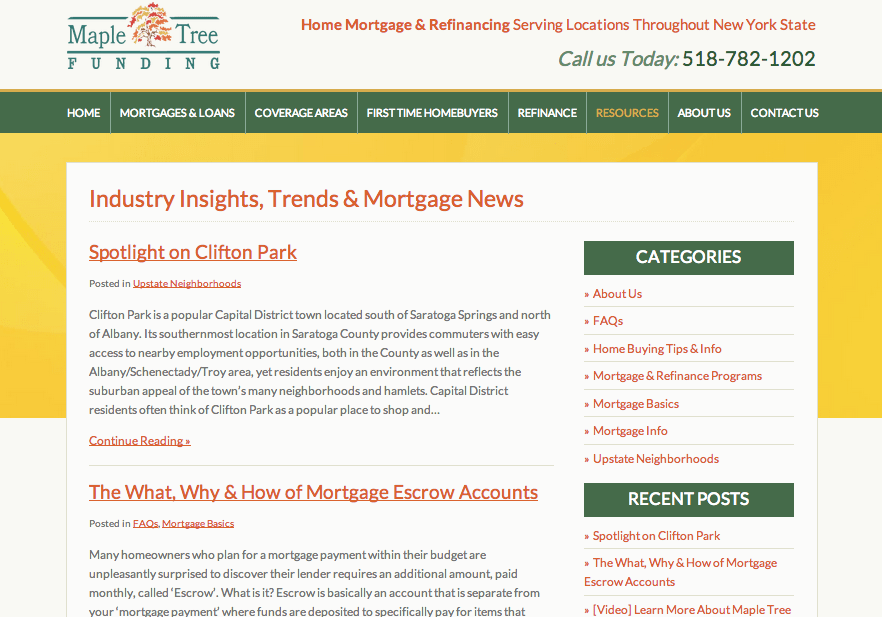Blogging can be a great technique for growing your presence in the search engines, attracting more buyers to your website, and converting visitors into leads. If you’re considering adding a blog to your website to expand your inbound marketing efforts, then this article will help you get started by answering some of the most common questions about blogging.
What is a Blog?
A blog is simply an area on your website where you can publish articles related to your business and industry.
A blog doesn’t necessarily have to be called “Blog” on your website; it could be called something along the lines of “News,” “Articles,” “Home Buyer/Seller Tips” (for real estate agents), or – my personal favorite- “Learning Center.”
What’s the Purpose of a Blog?
The purpose of a blog will vary from one company to the next, but the businesses who get the most out of blogging are the ones who use their blog to educate potential customers and keep them informed on the latest trends that are affecting their industry.
Maple Tree Funding (client) has a blog on their website which they use to post information that helps educate people who are interested in getting a loan or mortgage.

By publishing articles related to mortgages and loans, refinancing, buying a home, etc., Maple Tree Funding helps shoppers get answers to their most common questions about the loan buying process.
In addition, by addressing these specific topics on the blog, Maple Tree Funding is improving their competitiveness in the search engines as each article they publish on their website incorporates some of the keywords shoppers are typing into the search engines to find their services.
What Type of Information Should I Post on a Blog?
Many businesses believe that they can post articles from other websites directly onto their own blog, but this is a common misconception that could actually get you penalized by the search engines.
While sharing articles from third-party websites that are relevant to your audience is a good strategy for Facebook and Twitter, it can be dangerous to apply this strategy to your blog because Google and other search engines will consider this information “scraped” content. Scraped content is information that is taken directly from one website and then published on a different website.
Fortunately, there’s a much better way to provide your visitors with helpful information while avoiding penalties from the search engines. By publishing unique articles from your own perspective you’ll be able to communicate your own knowledge to potential customers who visit your blog. At the same time, this one-of-a-kind content that’s being published on your website tells search engines that your content is unique.
Does a Blog Post Have to be Text?
Not at all! The information you share through your blog can be conveyed in multiple formats, and the most common types include written articles and short videos.
For example, in a recent post on the Mannix Marketing blog we published a short video wherein I explain the difference between mobile websites and responsive designed websites.
While this information could certainly be communicated in text format, we felt it was important to have the person who meets with business owners about their inbound marketing verbally explain the differences in a video. On that note, video is great for helping potential customers see you before they meet you, especially if you’re in the service industry and interacting with your customers on a regular basis.
Of course, if you are posting a video to your blog, then you should accompany the video with some text which outlines the main points (as seen in the mobile vs. responsive websites article).
Regardless of which medium you choose for your posts, the goal is always to provide quality information that is helpful to your target audience.
How Long Should a Blog Post Be?
Once you have an idea for the specific topics you plan to address on your blog, the next question is probably going to be “how long should my blog post be?”
Blog articles typically range anywhere from 200-800 words. If that sounds like a daunting task, well there’s actually a much simpler solution that will make your writing process much more enjoyable (yes, enjoyable!) and effective:
A blog post should be as many words as it takes for you to make your point.
Whether it takes you 200 words or 2,000 words, as long as your content helps your target audience solve a specific problem then you’ve created something of value.
Getting Started with Blogging
Obviously there are many other questions you’ll be asking yourself about starting a blog and using it to grow your presence in the search engines, attract more visitors to your site, and acquire more leads from the web. If you’d like to learn more or get a specific question answered then feel free to contact me today.


